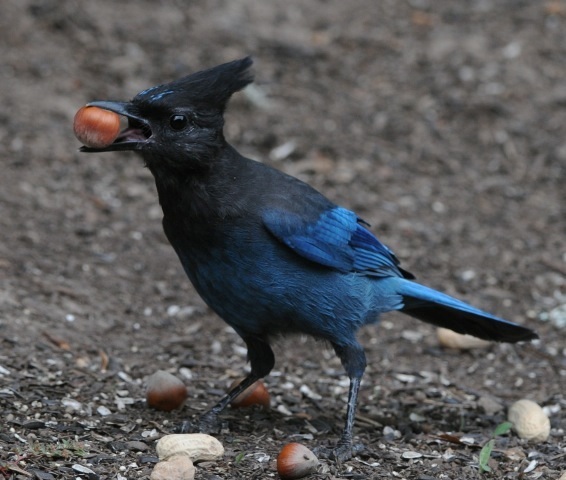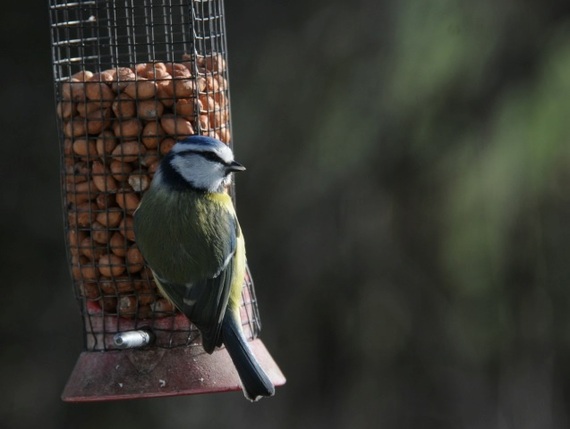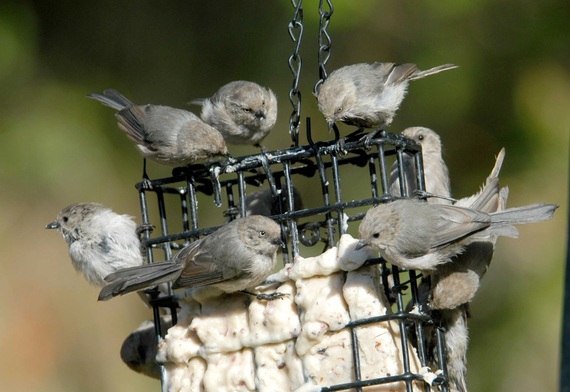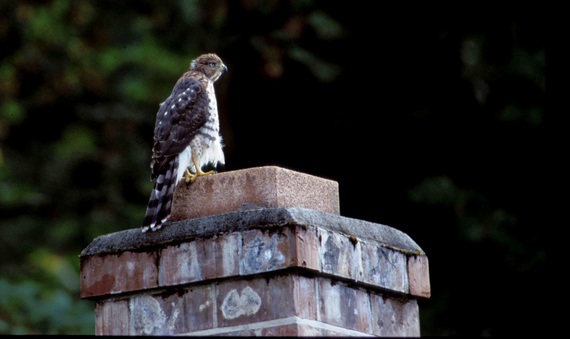I know fall has come because the Steller's Jays are screaming at me.
They are screaming because it is the season for storing hard nuts and they want me to toss hazelnuts and peanuts out to them. I have for years. It is a ritual of the season. I mimic their shrill "zzreeet" call and toss out the nuts. They scream in return before swooping down to grab a nut, then flying off to cache it in the ground in different locations they will remember through the winter.

Who is training whom? A Steller's Jay selects a hazelnut for caching and later winter retrieval. Photo by Steve Zack ©WCS.
Three years ago, there was a sharp tapping on our wooden front door and I opened it to see a jay stare at me then fly away, squawking. It was fall and I hadn't yet fed them. Truly.
I feed birds and I am not alone. More than 40 percent of U.S. households regularly feed birds (75 percent of U.K. households do). In fact the number of people who feed birds exceeds the combined figure for those who hunt and fish. We put out an astonishing billion pounds of seed annually for birds, and spend some $4.5 billion in doing so.
Bird watching, via bird feeding, is clearly the most frequent human-wildlife interaction. In our increasingly urbanized world, feeding birds is, for millions of people, our most significant direct connection to nature.

A Blue Tit feeding on peanuts in the U.K. A higher percentage of birds are fed in the U.K. than anywhere else in the world. Photo by Steve Zack ©WCS.
I keep separate feeders: one with sunflowers, one with millet mix, and one with thistle seed; I have two with suet variations; and two hummingbird feeders (and these do not include the diverse seed I throw on our bare soil). These feeders are all close to the house and easily seen from my home "office" (laptop, kitchen table, chair) here in Portlandia.
A suburban forest behind the house provides habitat for the birds, but the food brings the bird diversity out into view. It is my pleasant distraction during the working day. Because I work on bird conservation issues across the globe, my backyard with feeders brings a smaller world of birds constantly into view.
It is also a chance to watch bird behaviors, including their social interactions, close up. I constantly interpret the natural world outside my window, as I do on my professional trips into the field. The jays cache hard nuts, while the chickadees (Black-capped and the Chestnut-sided) and the Red-breasted Nuthatch take sunflower seeds and cache them on tree branches and trunks.

Bushtits, chickadee relatives, crowd a suet feeder. Bushtits are highly social birds and travel in large flocks during the winter. Females are pale-eyed, males are dark-eyed. Photo by Steve Zack ©WCS.
The Bushtits, tiny chickadee relatives, arrive in the group of some twenty strong and crowd the suet feeders. Our resident male Anna's Hummingbird dominates one feeder, but can't dominate both; the other feeder allows female and immature birds to gain a meal. All that activity feeds my interests and fuels my imagination.
Occasionally bitter weather intensifies the action and draws in cold-climate species I see infrequently, like the Varied Thrush and the striking Townsend's Warbler, or even Band-tailed Pigeons who will stop by to see what all the commotion is about even though their dietary needs are elsewhere. My feeders are both the cause of this commotion and allow me to benefit from it.
The feeders also allow some birds to benefit indirectly. Cooper's Hawks sometimes swoop in and grab a chickadee or a sparrow near my feeders. Thus I am contributing to a food chain by feeding birds at the lowest level.

A Cooper's Hawk surveys the neighborhood from our neighbor's chimney. Cooper's Hawks feed on the birds we feed. Photo by Steve Zack ©WCS.
When we lived in Northern California with a creek beyond our backyard, I would throw seed across the lawn and attract White- and Golden-crowned Sparrows -- and a regular Cooper's Hawk. There, the hawk flushed errant birds into our patio window, simplifying its effort of capture.
One time I watched the hawk fly quickly and low across the yards lined along the creek, using the wooden fences as cover. It clearly knew where all the feeders were in the neighborhood, and made the rounds efficiently and effectively.
Do we help or hurt the birds we feed? A few studies on Cooper's and Sharp-shinned Hawks suggest that the hawks don't focus particularly on where we feed birds, and so we are not putting feeder birds at undo risk of predation. (Risk due to house cats is a whole other concern!)
Overall, studies suggest that our feeding does seem to increase the survival of our feeder birds. Further, the effects of our winter feeding often helps these birds raise more young in the spring (though one study does warn that some species may be negatively affected by an imbalanced diet, heavy on seeds provided by us and little else.)

The wary Pileated Woodpecker is finally a regular visitor to our suet feeder. Only in the past year has it come down to feed. Photo by Steve Zack ©WCS.
Jays are ferocious nest predators of smaller songbirds and they may concentrate their predation on our other feeder birds nesting nearby in the spring. Our feeding of jays may help them survive better, focus their territorial activities around us, and so increase the chances that they later nest nearby and feed on local songbird young in the spring.
On balance, while we occasionally hinder the birds we feed, we largely help them. But that benefit to birds may turn out to pale in comparison to the benefits they provide us by calling our attention to the glorious diversity of birds and their behaviors just outside our windows. They are my working day connection the larger world of birds and feed my compulsion to be part of larger efforts to conserve them.